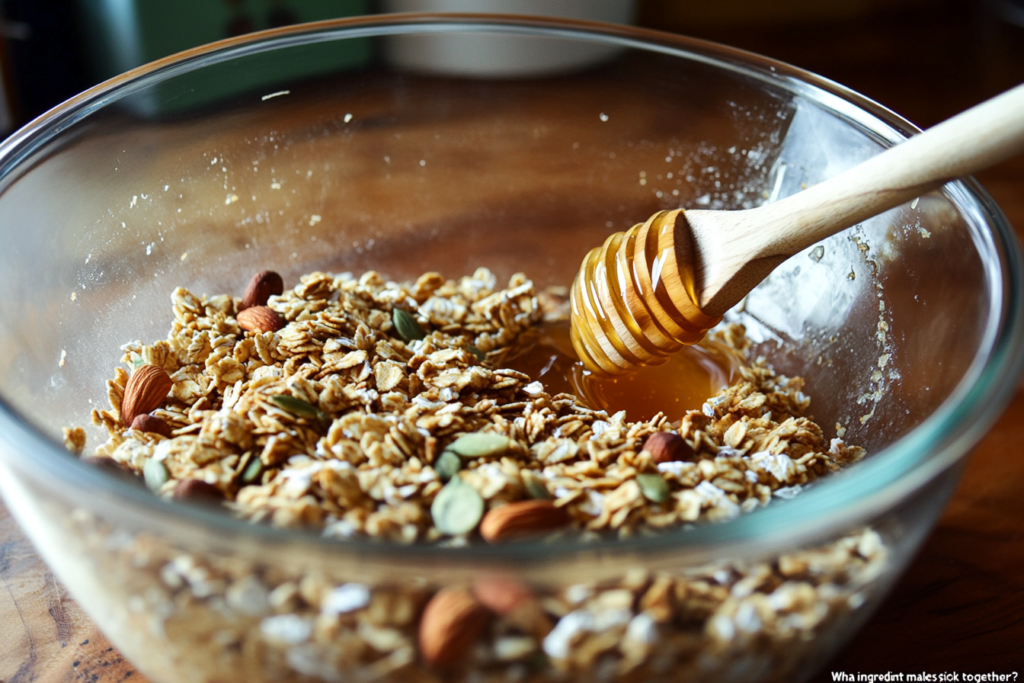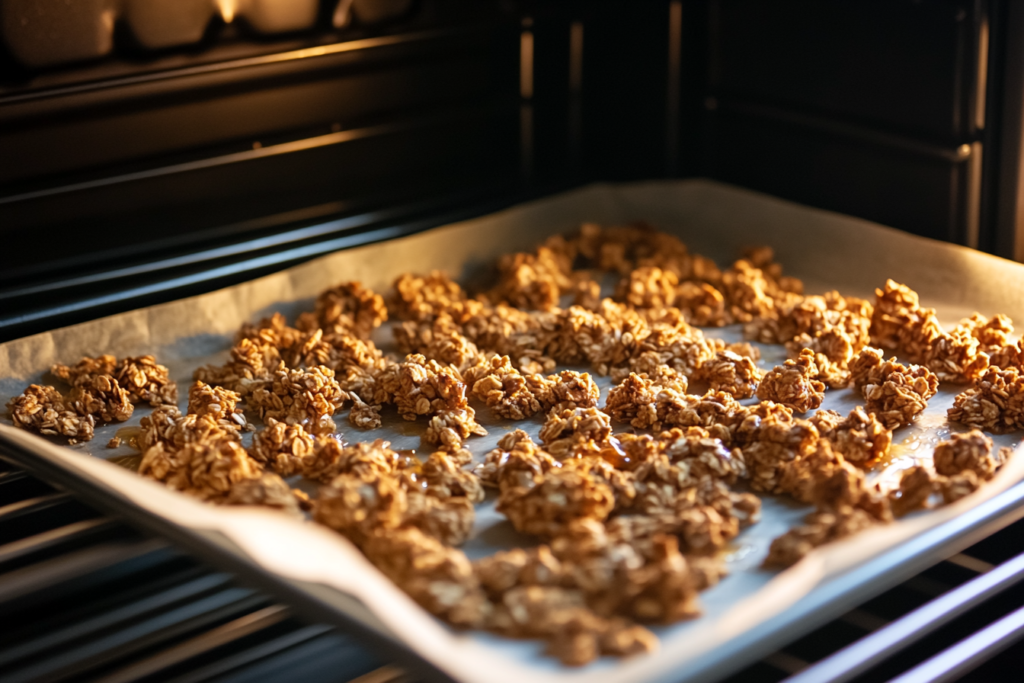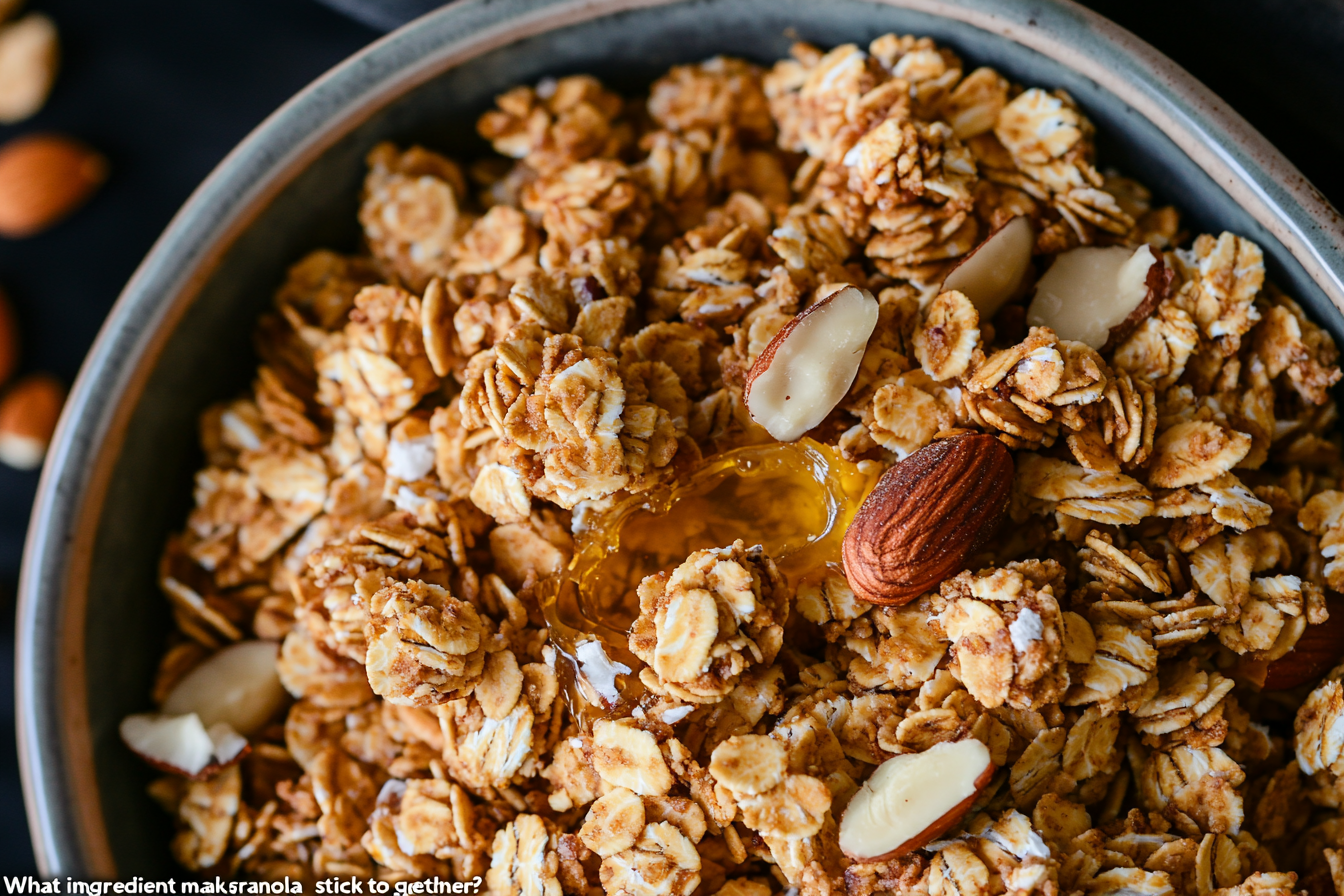Discover the ideal binding ingredients for creating perfectly clumpy, delicious granola.
Below is a comprehensive guide on What ingredient makes granola stick together? Follow it to master granola-making and achieve irresistibly crunchy clusters at home.
THE OUTLINE
- Introduction
1.1 Brief overview of homemade granola’s popularity
1.2 Importance of clumping for flavor and texture
1.3 Introduce the focus keyword What ingredient makes granola stick together? - The Role of Key Components
2.1 Oats, nuts, and seeds as the base
2.2 Liquid sweeteners and fats
2.3 Additional flavor enhancers (spices, extracts, dried fruit) - The Science of Stickiness
3.1 Chemistry of sugars and fats
3.2 Caramelization and texture development
3.3 Moisture balance in granola - Different Binding Agents
4.1 Honey, maple syrup, and agave nectar
4.2 Oils and butter
4.3 Nut butters and fruit purees - Tips for Making Granola Stick
5.1 Proper ratios of dry to wet
5.2 Oven temperatures and timing
5.3 Stirring techniques
5.4 Cooling process and clump formation - Troubleshooting
6.1 Overly dry granola
6.2 Too wet or soggy texture
6.3 Burnt edges or uneven browning
6.4 No clumps after baking - Variations and Substitutions
7.1 Vegan granola without honey
7.2 Nut-free, seed-based alternatives
7.3 Low-sugar and low-oil strategies - Serving Suggestions
8.1 Breakfast bowls, parfaits, smoothie toppers
8.2 Granola bars and snack mixes
8.3 Dessert uses and creative applications - Frequently Asked Questions (FAQs)
9.1 How to get granola to stick together?
9.2 What makes granola bars stick together?
9.3 What is the binding agent in granola?
9.4 Why is my granola not clumping? - Conclusion
10.1 Key takeaways
10.2 Encouragement to experiment
1. Introduction
Granola is a beloved breakfast and snack staple, especially in the United States. It comprises oats, nuts, seeds, sweeteners, and perhaps some fruit. However, the secret to achieving those satisfying clumps is not always obvious. Many home cooks wonder why their granola crumbles into dry flakes instead of sticking together as tempting clusters. That is where our focus keyword What ingredient makes granola stick together? comes into play.
Accordingly, oats deliver whole-grain benefits, which make granola a wholesome addition to a balanced diet. Therefore, paying attention to the right binding ingredients allows you to maintain both nutritional value and excellent taste. Additionally, homemade granola can be healthier than store-bought varieties. It often contains fewer preservatives and less processed sugar.
In the paragraphs ahead, we will discuss how sugars, fats, and specific techniques influence granola’s stickiness. We will also include several tips for troubleshooting and variations. Eventually, you will know the best ways to create firm yet slightly chewy clusters that never feel dry. Let’s begin by exploring how each component of granola works together.
2. The Role of Key Components
2.1 Oats, Nuts, and Seeds as the Base
Most granola recipes start with old-fashioned rolled oats. Because rolled oats retain their shape and structure under heat, they are ideal for forming crunchy clusters. Nuts, such as almonds or walnuts, and seeds, like pumpkin or sunflower seeds, offer texture and additional flavors. Besides, these deliver beneficial fats, protein, and vitamins, making the granola more nutritious.
2.2 Liquid Sweeteners and Fats
What ingredient makes granola stick together? Often, the quick answer is liquid sweeteners like honey or maple syrup. These liquids penetrate the rolled oats, soaking into small crevices and adding sweetness. Comparatively, fats (for example, coconut oil or melted butter) also coat the oats and nuts. Fats help form a toasty outer layer when baked. Together, sugars and fats create the “glue” that binds clusters.
2.3 Additional Flavor Enhancers
Spices like cinnamon or nutmeg can intensify granola’s cozy warmth. Certainly, dried fruits such as raisins or cranberries lend pops of sweetness and chewiness. Vanilla or almond extract adds a pleasant aroma. Albeit these don’t directly contribute to stickiness, they can influence moisture levels slightly if added in larger quantities.
3. The Science of Stickiness
Mastering the science behind clumping helps you control the outcome.
3.1 Chemistry of Sugars and Fats
When sugars (honey, maple syrup, agave nectar) heat up, they loosen and coat the grains. Concurrently, fats melt and envelop each flake of oat. As the granola cools, these sugars and fats solidify. Hence, they fuse everything into clumps. The ratio of sugar to fat can determine how dense your clusters are.
3.2 Caramelization and Texture Development
A moderate oven temperature allows sugars to caramelize slowly. Henceforth, the caramelization lends granola its signature golden color and subtle crispness. When caramelization occurs too quickly at a high temperature, sugar can scorch. Moreover, the burnt flavor may overshadow other ingredients.
3.3 Moisture Balance in Granola
Basically, moisture plays a key role in binding. If there is not enough sticky fluid, the granola remains dusty or powdery. If there is too much liquid, the mixture turns soggy and struggles to crisp. Therefore, balancing your recipe’s ratios is critical.
4. Different Binding Agents
Now, let us examine the most common culprits for creating clusters.

4.1 Honey, Maple Syrup, and Agave Nectar
Honey is the classic answer to What ingredient makes granola stick together? due to its thick viscosity. Likewise, maple syrup or agave nectar can produce similarly satisfying results, albeit with slightly different flavors. Still, all three sweeteners offer the sugar content needed to create a sticky network of caramelized goodness.
4.2 Oils and Butter
Coconut Oil
Coconut oil gains popularity because it becomes solid at cooler temperatures. Thus, it helps firm up granola once it cools. It may add a mild coconut essence, which can be delightful if you enjoy tropical flavors.
Butter
Butter imparts a rich, savory depth. Nonetheless, it can burn if your oven runs hot. Keep an eye on your baking time when using real butter.
Other Oils
Canola, olive, or grapeseed oil can also serve as binding fats. Nevertheless, they may not create as firm a cluster as coconut oil or butter unless you adjust the sweetener ratio.
4.3 Nut Butters and Fruit Purees
Nut Butters
Peanut butter, almond butter, or cashew butter can reinforce granola’s binding mechanism. Conversely, they can sometimes weigh the mixture down if used excessively. Start with small amounts to see how they affect your texture.
Fruit Purees
Mashed banana, applesauce, or even pumpkin puree can add stickiness without processed sugar. Comparatively, they may not crisp as much in the oven. Yet, they can create tender clusters that are healthier for those reducing sugar intake.
5. Tips for Making Granola Stick
Although picking the right binder is crucial, technique matters too. Heading into the subsequent area, let us discuss best practices.
5.1 Proper Ratios of Dry to Wet
Granola typically features about 3 parts oats to 1 or 1.5 parts nuts and seeds. Then, a ratio of roughly ½ part sweetener to ½ part fat can be a starting place. However, every recipe differs. So, experiment in small increments to achieve your ideal texture.
5.2 Oven Temperatures and Timing
Aim for an oven temperature around 300–325°F. Comparatively, higher temperatures can burn the sugars. Bake for 20 to 30 minutes, stirring once or twice if you want smaller clusters. Alternatively, do not stir at all if you prefer big chunks.
5.3 Stirring Techniques
Stirring mid-bake exposes more surface area to heat, resulting in even color. But, frequent stirring breaks up potential clusters. If you love big pieces, then spread the mixture, press it gently, and skip stirring entirely.
5.4 Cooling Process and Clump Formation
Let your granola cool completely on the baking sheet. Subsequently, the sugars and fats will harden, forming crisp clusters. If you stir too soon, you might destroy the structure. Therefore, patience is essential.
6. Troubleshooting
If you experience granola fails, in the ensuing segment, find out why.

6.1 Overly Dry Granola
- Possible Causes: Not enough sweetener or fat, oven too hot, or excessive stirring.
- Fix: Slightly increase your liquid sweetener or oil. Lower your oven temperature if it browns too fast.
6.2 Too Wet or Soggy Texture
- Possible Causes: Too much added liquid, or insufficient baking time.
- Fix: Bake for a few extra minutes. Add more oats or seeds to absorb moisture. Keep an eye on color to prevent burning.
6.3 Burnt Edges or Uneven Browning
- Possible Causes: Oven hot spots, inadequate stirring (if you prefer uniform color), or clustering the granola too densely.
- Fix: Rotate your baking sheet halfway through. Spread the mixture in a thinner layer.
6.4 No Clumps After Baking
- Possible Causes: Insufficient binding ingredients or stirring too often.
- Fix: Increase the sugar or fat content. Minimize how frequently you disrupt the granola during baking.
7. Variations and Substitutions
Shifting to the next part, let us explore creative alternatives.
7.1 Vegan Granola Without Honey
Opt for maple syrup or agave nectar. Finally, ensure your chosen oil is plant-based, such as coconut oil or avocado oil. Nut butters also work wonders in vegan recipes.
7.2 Nut-Free, Seed-Based Alternatives
Replace nuts with extra seeds if allergies are a concern. Similarly, shredded coconut can add richness and variety in place of nuts. Surely, you can still get those clusters without tree nuts.
7.3 Low-Sugar and Low-Oil Strategies
Experiment with mashed bananas or applesauce. Still, keep in mind the granola might be chewier. Hence, the clusters will be less crisp but remain cohesive due to the natural sugars and pectin in fruit.
8. Serving Suggestions
Advancing to the next topic, granola shines in many dishes.
8.1 Breakfast Bowls, Parfaits, Smoothie Toppers
- Bowls: Enjoy a generous serving of granola with milk or plant-based alternatives. Top with fresh berries or bananas.
- Parfaits: Layer yogurt, fruit, and granola in a glass. Eventually, you get a visually appealing and protein-packed treat.
- Smoothie Toppers: Sprinkle granola on top of your favorite smoothie for added crunch and fiber.
8.2 Granola Bars and Snack Mixes
Press warm granola into a parchment-lined dish, and let it cool. Before cutting it, ensure it has set completely so the bars do not fall apart. Combine leftover granola with dried fruits, chocolate chips, or pretzels to form a snack mix.
8.3 Dessert Uses and Creative Applications
On to the following discussion, here are the most frequent queries.
9. Frequently Asked Questions (FAQs)
Granola crumbles can become a topping for ice cream or fruit crisps. Thus, it adds an appealing crunch. You can also fold granola into cookie or muffin batters for a heartier texture.
1.How to get granola to stick together?
You can use honey, maple syrup, or nut butters. Additionally, avoid stirring the granola too often and let it cool fully on the baking sheet.
2.What makes granola bars stick together?
Granola bars often depend on thicker sweeteners like honey or brown rice syrup, combined with binding agents (e.g., peanut butter). Correspondingly, these are pressed firmly into a pan and sometimes chilled to set.
3. What is the binding agent in granola?
Normally, the combination of sugar and fat forms a cohesive agent. Specifically, honey or maple syrup plus oil or butter are the leading components.
4. Why is my granola not clumping?
Common reasons include not enough sweetener, over-stirring, or baking at an overly high temperature. Accordingly, reduce stirring and monitor the heat level.
10. Conclusion
In the next subsection, let’s summarize our findings. What ingredient makes granola stick together? is often a well-chosen blend of sweeteners and fats. Certainly, you can experiment with honey, maple syrup, agave nectar, or nut butters. The trick lies in balancing dry and wet ingredients while using proper baking and cooling methods. Also, remember that adjusting ratios and oven temperature can produce slightly different textures. Granola lends itself to personal customization. Consequently, you can find a mix of flavors that suits your taste buds perfectly.
Overall, do not be discouraged if your first few attempts yield less-than-ideal clusters. Occasionally, trial and error is part of the fun. The reward for your patience is a jar of fresh, golden-brown granola that stays clumpy for days. Give various binders a try, monitor your ratios, and enjoy the process.

